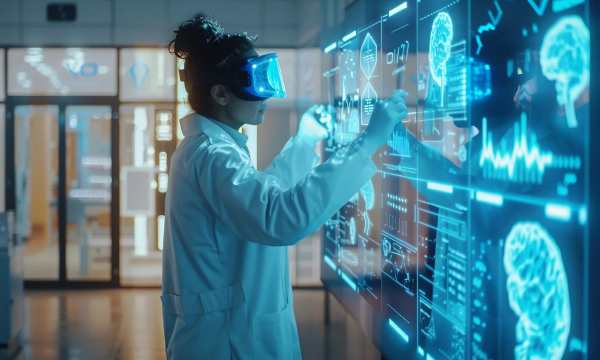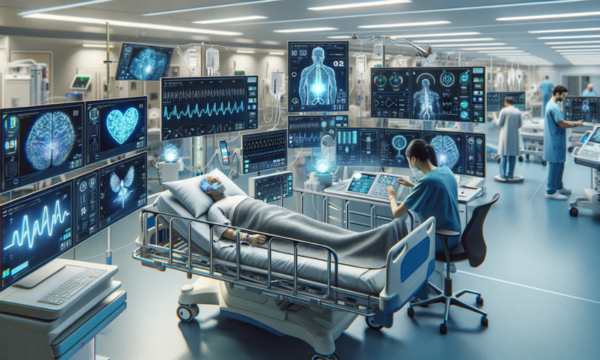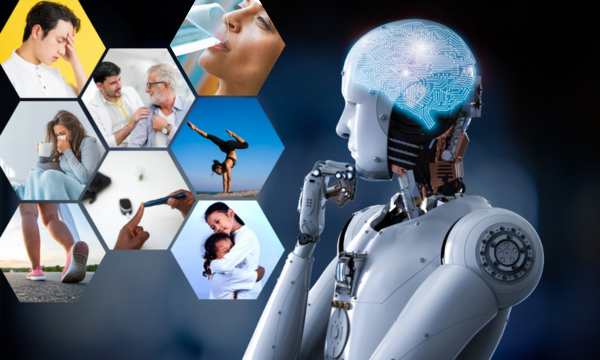With each new technology, the field is expanding and new teaching methods are emerging, making medical training even more engaging and effective.
Ad
If you are passionate about innovation in healthcare, you will notice how these tools are changing the way we learn, train, and prepare to care for people.
In this article, you will understand how AI and VR have become allies for those seeking quality and excellence in their education.
We will cover benefits, challenges, and highlight trends that are already being adopted by major educational institutions.
Throughout the text, it becomes clear that investing in technology is no longer just a choice it’s a necessary step to stay current and competitive.
AI and VR in the Creation of Immersive Learning Environments
Imagine being able to perform complex procedures in a controlled environment, with details almost as real as an operating room. With the combination of AI and VR, medical students and professionals experience precise, immersive simulations, filled with the variables of hospital routines.
The virtual environment helps reduce beginner anxiety, allowing learning to progress at the pace best suited to each person’s needs.
Medical training gains dynamism, since scenarios can be repeated multiple times without risk or wear on real patients. This repetition is fundamental for developing competence and confidence.
Each medical training session carried out this way brings students closer to excellence, as virtual reality allows for the simulation of complications, unexpected events, and common clinical practice challenges.
Those who train with AI and VR understand, in practice, the value of applied knowledge, gaining experience in situations that could never be replicated in traditional teaching.
How AI Adapts Medical Training to Each Individual
The great differentiator of artificial intelligence in medical training is the personalization of learning. Each student learns in their own way, at their own pace, and with distinct needs, and AI understands these differences like no other method.
By analyzing performance data, AI identifies strengths and areas needing improvement. This means training is tailored to each individual, advancing through content or revisiting essential concepts when necessary.
If a student repeatedly makes mistakes in a virtual procedure, the system suggests extra exercises or theoretical reinforcement, making their progress more efficient.
The goal is to ensure each professional is truly prepared, getting the most out of their training. This personalized approach reduces learning time, values practical experience, and avoids wasting time on content already mastered.

VR-in-medical-training-(Source-Google)
Benefits of VR Simulation with Virtual Patients
Simulating care using virtual reality is a major breakthrough for medical training. On these platforms, it’s possible to interact with virtual patients who have different personalities, symptoms, and needs, making the challenge even closer to reality.
Medical training in VR allows each student to practice not only technical skills but also communication, empathy, and clinical reasoning.
Mistakes happen without risk, and every simulation brings concrete lessons about decision making and problem solving.
Moreover, instant feedback is key in helping students understand what they did right and where to improve.
When students face similar situations in real life, they feel more prepared and confident, thanks to medical training based on virtual reality and simulated patients.
Study Progression System with AI Monitoring
Continuous progress is one of the pillars of successful medical training, and AI plays a key role in this aspect. Intelligent systems monitor every stage, tracking performance, time dedicated, and types of challenges faced in each session.
From this monitoring, training is adjusted to ensure the development of essential competencies, always respecting individual needs.
Constant monitoring allows for quick interventions, preventing doubts from piling up or insecurities undermining learning.
Additionally, detailed reports make it easier for educators to track progress, strengthening the teacher student partnership.
AI-mediated medical training streamlines study organization, making planning more strategic and motivating. Knowing that their progress is tracked and recognized pushes students to keep advancing, making the most of their abilities.
How Virtual Practice Can Improve Clinical Precision
Clinical precision results from repetition, attention to detail, and careful practice. Virtual practice, combined with AI-driven training, offers the chance to revisit complex procedures as often as needed.
Each simulation provides data, statistics, and performance analysis, helping identify minor mistakes that, in real situations, could impact patient care.
Medical training in virtual environments reduces stress, helps focus on essential techniques, and develops the fine motor skills needed for delicate procedures.
In virtual labs, mistakes become immediate learning opportunities, shaping more confident and skilled doctors.
Clinical precision gained through innovative training directly impacts the quality of care and patient safety, creating a new generation of professionals ready to face modern medicine’s toughest challenges.
Challenges of Implementing AI and VR in Medical Education
The adoption of AI and VR in medical training brings amazing advances, but also requires attention to important challenges.
Initial investment in equipment and infrastructure remains a barrier, especially for smaller institutions or those in less privileged regions.
Constant system updates are needed to keep training aligned with the latest and safest practices, preventing content from becoming outdated.
Another sensitive point is the need to properly train teachers and tutors to fully utilize these tools.
Overcoming resistance to new technologies is part of the process, and a mindset shift is essential for success. Medical training needs to be dynamic to adapt to new demands and integrate new technology consistently.
Ethical use of student data is also a recurring issue, requiring clear policies to guarantee privacy and respect.

Technological-advances-in-healthcare-(Source-Google)
Trends and Innovations in AI and VR in Medical Training
What can we expect from the future of medical training with AI and VR? Trends point to experiences that are increasingly realistic, with 3D sensory environments, augmented reality integration, and even biometric sensors for real time feedback.
Medical training is becoming more collaborative, connecting multidisciplinary teams from anywhere via virtual classrooms.
AI support is promising to interpret simulated patients’ facial expressions, making clinical analysis even more accurate and human.
Adaptive, AI-based educational programs are creating individualized learning paths, optimizing learning even more.
Additionally, there’s a strong trend toward democratizing these technologies, making advanced medical training accessible to institutions of all sizes.
It’s a path of constant evolution, opening new possibilities for those seeking excellence in medicine, always with a focus on ethics, innovation, and patient care.
Conclusion
Technology has become a great ally in medical training, transforming for the better how doctors and students learn and practice.
Artificial intelligence and virtual reality open doors to a new standard of excellence, making learning safer, more efficient, and tailored to each individual.
Those who invest in these technologies strengthen their skills, build confidence, and contribute to more humane and precise patient care.



